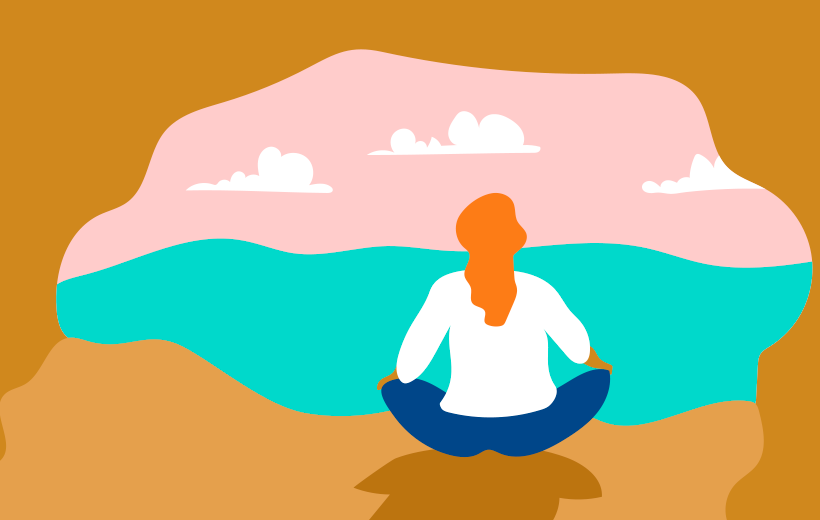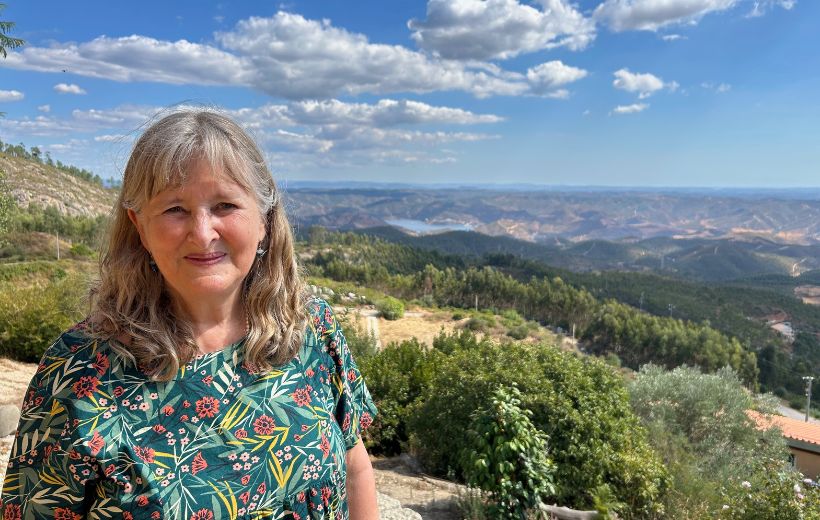Reminders for Practicing on Retreat
By Myoshin Kelley • 3 min read

This reflection by Tergar Instructor Myoshin Kelley was shared with students participating in a Tergar Retreats month-long Joy of Living 1, 2 & 3 retreat this fall in Portugal.
SOMETIMES WHEN WE SIT DOWN TO PRACTICE, we can lose our bearings. We forget what’s helpful and may wonder what we’re doing. So I’d like to share a few reminders — things that can support us in the midst of practice.
Having Clarity About the View
The first reminder is having clarity about what we’re doing. The view is that we are fundamentally okay. In our basic nature, nothing is flawed. Everything is pure, whole, and complete. We are endowed with qualities of awareness, loving-kindness, compassion, and wisdom. These are naturally inherent within us.
Of course, our habituated mind doesn’t believe this. It constantly points out our shortcomings. Our practice is to know for ourselves that we are already whole, to recognize these qualities and see how they are present moment by moment in our lives.
Years ago, I practiced with a Zen master, Hogen Daido Yamahata. In an interview, I felt as if he backed me into a corner until I could clearly see my own habit of thinking I was fundamentally lacking. That view — that I was flawed — was so ingrained. But practice invites a radical shift: from identifying with the flawed self to realizing that we are, at the core, fundamentally okay.
This is what our practice is — coming home to who we truly are, rather than the misperceptions we hold about ourselves. Even remembering this conceptually can ease our suffering. It shifts our attention away from habits of self-criticism toward the possibility of feeling at ease and whole.
Remembering Motivation
It’s also helpful to remember our motivation. In Burma, when I practiced, we chanted our aspiration many times a day — sometimes 17 times! Motivation recognizes that although all beings want to be happy, we get caught in greed, hatred, and delusion and end up perpetuating suffering.
Our aspiration is to see clearly, to understand, and to respond with compassion. And not just for ourselves — for all beings. Sometimes I simply remember the pain of a confused mind. As soon as I see that confusion, compassion naturally arises.
Awareness: Always With Us
In Joy of Living Level 1, we turn to awareness — the quality that’s always with us. It’s so close that we often overlook it. Before meditation, many of us never thought to appreciate awareness itself. Yet once we rest in it, awareness helps us see clearly.
Without awareness, we are run by habit, chasing the pleasant and pushing away the unpleasant. One moment of unpleasantness can change the course of our lives. I remember my nephew, who quit his job in a fit of rage and took a totally different path — just from that one moment.
When we know awareness, things shift. I recall a retreat where I spent weeks in rage, lost in righteous stories. Then suddenly: “This is anger.” The shift was monumental. Subtle and yet huge. I wasn’t the anger or the righteousness. I was simply aware.
Awareness is naturally endowed with compassion, kindness, and wisdom. Touching into it brings us to a fresh mind, a beginner’s mind. Each moment is new.

Myoshin Kelley at the Karuna Retreat Center near Monchique, Portugal
Attitude in Practice
It’s also worth looking at the attitude we bring to practice. Are we practicing to hold on to peaceful states (which is another form of greed)? Or are we practicing to make a friend of whatever arises — even the difficult friend? Difficult friends teach us a lot. So can difficult emotions.
Rather than repressing anger or judging ourselves, can we put the arm of awareness around it with kindness? When we do this, even tension can soften. Relaxation doesn’t mean peace — it means accepting what is, even when unpleasant.
Receptivity and Balance
Practice invites a sense of listening, receiving experience. Pain shifts, emotions change, and awareness can hold it all. But balance is important. Too much receptivity can turn into spacing out. Too much curiosity can turn into overthinking. So we learn to move between receptivity and alertness, always beginning again right where we are.
Another key is honesty. How often do we push aside aspects of experience we don’t like? Many of us grew up repressing anger. But known anger is very different from repressed anger. With awareness, anger loses its grip. We remember it’s not the sum total of who we are; it’s just weather, and weather changes.
Steadiness and Humor
Above all, steadiness matters. We’ll get lost over and over. That’s fine. Just keep coming back to awareness. The value lies in learning to be with our experience.
And finally, don’t forget humor. A teacher once told me, after trying many techniques for dealing with anger, that in the end, just laugh at your mind. Hold it lightly. I’ve had moments where the thoughts in my mind were so ridiculous I couldn’t help but laugh.
So these are just some things to remember as we practice: clarity of view, remembering motivation, knowing awareness, being honest, staying steady, and holding it all with humor and kindness.
I’ll end with a poem I wrote at the close of a retreat. It reflects how we can keep walking, no matter what arises:
Resolve of the Heart
Seeing the face of fear,
I quiver and I quake.
I become so small.
Two steps backwards,
And still I walk on.
The torment of the judging mind,
You or me,
It’s the thought that divides.
There is so much disdain,
And still I walk on.
Laziness prevails,
It clouds my vision.
Sometimes I think,
That my bed is nibbana
And still I walk on.
The unending sleepiness
That defies impermanence.
The bashing from its waves
Foggy, heavy, oppressive
And still I walk on.
Guilt, self-hatred,
They are friends that gang up
That lacerate and pierce
And I’m left in the muck.
And still I walk on.
Walk on, walk on.
It’s that whisper in my ear,
It’s that longing in my heart,
It’s that shiver of unspeakable peace.
And so I walk on.
October 2025

Myoshin Kelley is a long-time meditator who shepherded the development of Tergar International. Myoshin oversaw the development of Tergar groups and the training of community leaders. Myoshin lives with her husband Edwin Kelley on the Sapphire Coast of New South Wales, Australia, and they continue to serve Tergar, actively supporting Mingyur Rinpoche’s students as instructors. Myoshin leads “This Meditative Life” on Facebook.
Learn meditation under the skillful guidance of world-renowned teacher Yongey Mingyur Rinpoche at your own pace.


“The approach and flying into Kathmandu along the edge of the Himalayas is spectacular,” Hughes said. This, along with Boudhanath, a Tibetan enclave in Kathmandu, are among his highlights.

The new awareness yoga sequence can be performed sitting, standing, or even reclining. Instead of starting from the crown and working down the body, the flow is reversed, beginning from the ground and integrating movements upward and outward to the extremities.

He appreciated Rinpoche’s emphasis on applying the teachings anywhere and anytime. “I wanted a spiritual path that would infuse the entirety of my life,” Kell recalled.
If you enjoyed reading our articles, please join our mailing list and we’ll send you our news and latest pieces.